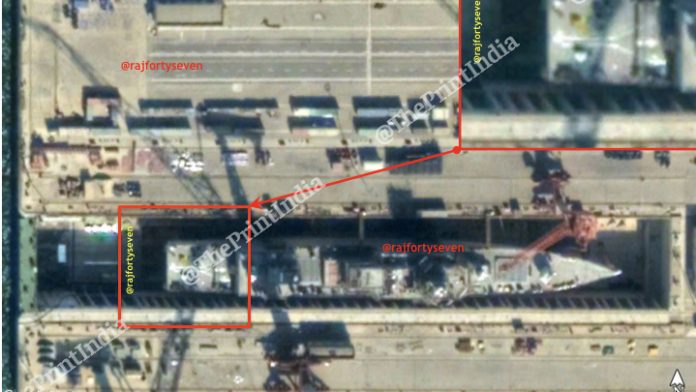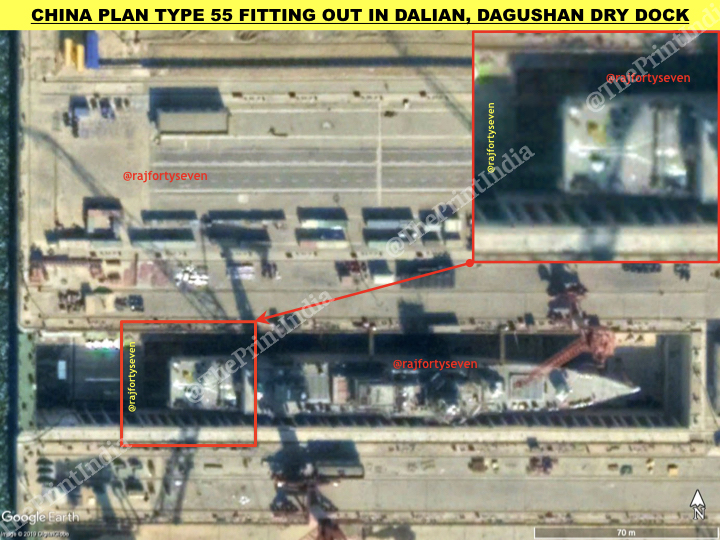
-
-
-
-
-
-
400Shares
New Delhi: China, which has built a reputation for churning out naval ships months before schedule, has found another way to further shrink the construction window, satellite images accessed by ThePrint show.
As ThePrint reported in 2017, the high speed of production at Chinese naval construction yards is driven by a feverish work schedule that knows no off-time: The construction staff works without holidays, in three eight-hour shifts, with work carried out simultaneously on different ships in one yard, or on one ship in different yards, to optimise the equipment, infrastructure and manpower available.
The new technique to rush the process centres on constructing dry docks apart from those meant for ship-building: Once a ship’s hull is built, satellite images show, it is shifted to the newer special dry docks for the fitting of equipment, thus allowing the construction of a new ship to begin at the building docks. This can speed up the process by months.
Satellite imagery shows that the Chinese navy (the People’s Liberation Army Navy or PLAN) is using these newer dry docks to increase the production rate of its latest cruiser, the Renhai-class Type 55, which is likely to be the mainstay of all expeditionary fleets of PLAN for the next 30 years.
Special dry docks
Dry docks are narrow basins or vessels that can be drained of water to allow the inspection and repair of a ship’s hull, which is the main body of the watercraft without the engine and other fittings.
They are employed for the construction of ships and other watercraft, as well as their repair.
The latest satellite images of two Chinese locations where Type 55 cruisers are being constructed — Dalian and Shanghai — indicate activity in dry docks away from the construction docks where the hull is built.

Dalian: The acquisition of Daeyang Shipbuilding Ltd, a Korean company, by China’s Dachuan Group in 2015 came as a boon for the designers and engineers of the Type 55 guided missile destroyer.
The repair yard of Dongbang Ship Machinery at Dagushan, about 17 km from the Dalian construction yard, was converted for naval use.
In the beginning of 2017, satellite imagery showed some kind of repair at one of the dry docks. Two special square-shaped pits were created below the dry-dock floor by the end of 2017.
The pits, of lengths 22 metres (m) and 28 m, are spaced about 125 m away from each other and can be flooded independent of the dry dock.


Shanghai: The second location in China where Type 55 is being constructed is Shanghai’s JiangnanChangxing (JNCX) shipyard. This shipyard is famous for quick production of the latest ships for the PLAN.
As many as 14 major vessels, in various stages of construction, have been noticed here at the same time in satellite imagery.
The civil dry dock west of the JNCX shipyard’s naval area has probably been taken over and re-designed for fitting-out Type 55 ships.
In the latter half of 2017, this dry dock, similar to the Dagushan facility, was endowed with two special pits spaced exactly 125 m apart: The only difference being that the pit in the fore is also 28 m, unlike at Dalian.

Also read: Satellite imagery reveals Chinese navy’s war games for a possible attack on Taiwan
Fitting out
These two special pits, it is assessed, were prepared so that the propeller system and bulbous bow could be fitted here, thus advancing the launch of vessels to months before schedule.
This saves the PLAN precious time, clears the dry dock for fresh constructions, and reduces overall production time.
One Type 55 being built at Dalian was observed at this Dagushan dry dock from November 2018 to 23 April 2019.
One of the propeller shafts can be observed in satellite imagery from the Dagushan facility, endorsing this assessment.
Recent satellite imagery of Shanghai JNCX indicates one of the Type 55s being fitted out at the newly-modified dry dock.
The bulbous bow of this ship is observed askew, suggesting it is probably being fitted on the ship on the date of the image.
Importance of bulbous bow
Bulbous bows in naval ships primarily provide safe-housing for sonar, but are also used advantageously for many other purposes.
The bulb attenuates the bow-wave system, resulting in reduced resistance. It is also used as a fore peak ballast tank, decreasing the hydro-dynamic effects of pitch.
A properly-designed bulb also helps in enhancing propeller cavitation. Thus, a bulbous bow provides large ships with much-needed speed, stability and fuel efficiency.